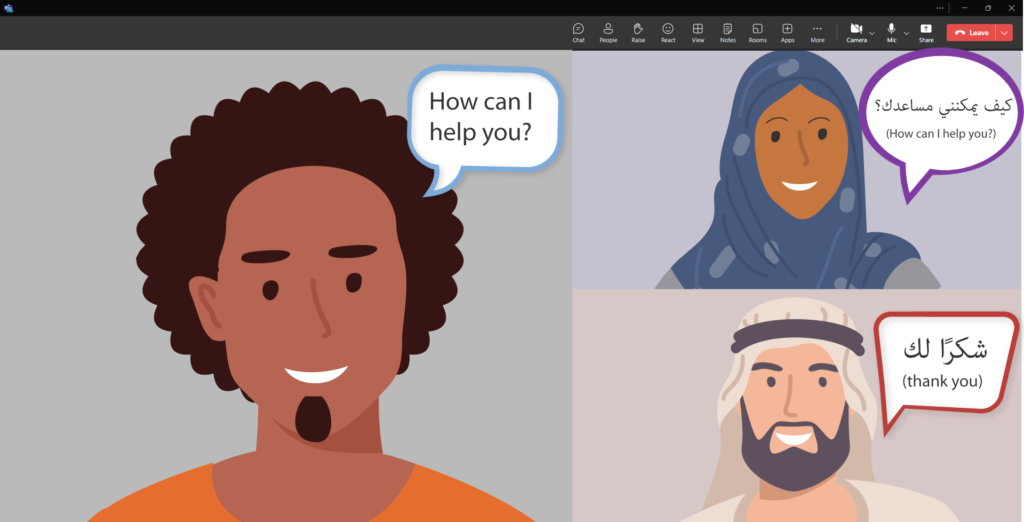
Telehealth has emerged as a transformative force in modern healthcare, revolutionizing the way medical services are delivered and accessed. This shift has been accelerated by technological advancements and the COVID-19 pandemic, which underscored the need for remote healthcare solutions. As telehealth continues to expand, it offers unprecedented opportunities to provide care to patients regardless of geographic limitations. However, for Limited English Proficient (LEP) patients, accessing these services can be fraught with challenges that impede effective communication and equitable care.
Language services are essential in bridging this gap, ensuring that LEP patients receive the same quality of care as their English-speaking counterparts. The integration of interpretation and translation services within telehealth platforms can facilitate clear and accurate communication between healthcare providers and LEP patients, overcoming language barriers that might otherwise hinder the delivery of care. This is not only a matter of convenience but a critical component of providing comprehensive, patient-centered care.
The Continued Growth of Telehealth
From April 2021 to August 2022, telehealth usage among adults fluctuated between 20.5% and 24.2%, with an average of 22% of adults reporting telehealth use in the last four weeks (ASPE). This suggests a stable utilization rate well above pre-pandemic figures. Furthermore, the American Medical Association (AMA) highlights that telehealth continues to be integrated into regular healthcare practices, with many temporary measures enacted during the pandemic being extended or made permanent to support ongoing use (American Medical Association).
Additionally, a report from USAFacts confirms that telehealth usage, although slightly variable, has maintained a significant presence in healthcare delivery. The report indicates that the initial surge in telehealth during the pandemic led to an enduring increase in its adoption, with usage rates stabilizing at higher levels than those seen before the pandemic (USAFacts).
Importance of Language Services in Telehealth
The integration of language services into telehealth platforms is essential for providing equitable healthcare access to Limited English Proficient (LEP) patients. Without these services, LEP individuals face significant barriers to understanding medical advice, adhering to treatment plans, and communicating their symptoms accurately, which can lead to poorer health outcomes.
Ensuring Effective Communication
Language barriers can impede effective communication between healthcare providers and LEP patients, leading to misunderstandings, misdiagnoses, and inadequate treatment. The use of qualified interpreters and translators in telehealth ensures that LEP patients receive accurate information and can fully participate in their healthcare. According to a study by the Agency for Healthcare Research and Quality (AHRQ), the use of professional interpreters in healthcare settings significantly improves the quality of care for LEP patients by enhancing communication accuracy and patient satisfaction (ASPE).
Legal and Ethical Obligations
Healthcare providers are legally and ethically obligated to ensure that all patients, regardless of language proficiency, have access to the information they need to make informed decisions about their health. The Civil Rights Act of 1964 mandates that any organization receiving federal funds must provide language assistance to LEP individuals. Additionally, healthcare providers must comply with the Americans with Disabilities Act (ADA), which requires the provision of effective communication for patients with disabilities, including those with language barriers (USAFacts).
Enhancing Patient Outcomes
Research has shown that providing language services in telehealth can lead to better health outcomes for LEP patients. A study published in the Journal of General Internal Medicine found that LEP patients who received interpreter services were more likely to understand their diagnosis, treatment options, and follow-up care instructions, leading to higher rates of treatment adherence and better overall health outcomes (ASPE) (USAFacts). Furthermore, culturally and linguistically appropriate services help build trust between patients and providers, which is critical for effective healthcare delivery.
Addressing Health Disparities
The integration of language services in telehealth is also a crucial step in addressing health disparities among diverse populations. LEP patients often face significant challenges in accessing healthcare services, leading to disparities in health outcomes compared to English-proficient patients. By incorporating language services into telehealth platforms, healthcare providers can help mitigate these disparities, ensuring that all patients have equal access to quality care.
Technological Integration
Modern telehealth platforms are increasingly incorporating features that support multilingual communication. This includes real-time video interpretation, audio interpretation, and text-based translation services. These technologies enable healthcare providers to deliver seamless and efficient care to LEP patients, regardless of their location. The use of HIPAA-compliant platforms ensures that patient information remains secure and confidential, further supporting the integration of language services into telehealth (USAFacts).
In summary, the importance of language services in telehealth cannot be overstated. They are vital for ensuring effective communication, meeting legal and ethical obligations, enhancing patient outcomes, addressing health disparities, and leveraging technological advancements to provide comprehensive care. By prioritizing the integration of language services, healthcare providers can significantly improve the quality and accessibility of telehealth for LEP patients.
Best Practices in Telehealth Interpreting Administration
These strategies can help healthcare providers deliver high-quality, equitable care to Limited English Proficient (LEP) patients while ensuring compliance with legal and regulatory requirements.
Using HIPAA-Compliant Platforms
One of the primary concerns when integrating language services with telehealth is ensuring the security and privacy of patient information. HIPAA-compliant platforms are essential for maintaining the confidentiality of electronic protected health information (ePHI). These platforms should include:
- Encryption: All data transmitted during telehealth sessions, including video, audio, and text, must be encrypted to prevent unauthorized access.
- Secure Access Controls: Implementing robust access controls ensures that only authorized personnel can access patient information. This includes using strong authentication methods and regularly updating access permissions.
- Audit Trails: Maintaining detailed audit trails helps track who accessed patient information and when, providing an additional layer of security and accountability.
Training Healthcare Providers
Effective communication with LEP patients requires healthcare providers to be well-trained in both the use of telehealth technology and working with interpreters. Key training components should include:
- Technology Training: Providers should be familiar with the telehealth platform’s functionalities, including how to initiate and manage video calls with interpreters.
- Cultural Competency: Training on cultural awareness and sensitivity can help providers communicate more effectively with LEP patients and understand the cultural context of their health concerns.
- Effective Use of Interpreters: Providers should learn best practices for working with interpreters, such as speaking directly to the patient, pausing frequently to allow for interpretation, and ensuring the interpreter is included in all aspects of the consultation.
Providers should use plain language, avoid jargon, and check for understanding frequently. It is important to allow the interpreter time to convey meaning accurately and completely.
Partnership with Professional Language Service Providers
Collaborating with reputable language service providers can ensure access to qualified interpreters and high-quality translation services. These providers often have rigorous training and certification programs for their interpreters, ensuring they meet the necessary standards for medical interpretation.
Success Stories
Examples of how healthcare providers have successfully integrated language services into their telehealth platforms can offer valuable insights and practical lessons. These examples highlight effective strategies, best practices, and the positive outcomes achieved by overcoming communication barriers for Limited English Proficient (LEP) patients.
Improving Patient Engagement and Outcomes
A large healthcare system in California implemented a comprehensive telehealth program that included integrated language services. By using HIPAA-compliant telehealth platforms with built-in video remote interpreting (VRI), the system was able to offer real-time interpretation services in over 200 languages. This initiative led to several positive outcomes:
- Increased Access: LEP patients were able to access healthcare services more easily, leading to higher rates of appointment adherence and follow-up care.
- Improved Patient Satisfaction: Surveys indicated that LEP patients felt more comfortable and understood during their consultations, resulting in higher patient satisfaction scores.
- Better Health Outcomes: The use of qualified interpreters reduced the risk of miscommunication, leading to more accurate diagnoses and effective treatment plans.
Enhancing Emergency Care Communication
A community hospital in New York faced significant challenges in communicating with LEP patients during emergency situations. To address this, the hospital partnered with a professional language service provider to offer on-demand interpretation services via telehealth. The key elements of their approach included:
- Rapid Response: By having interpreters available 24/7, the hospital could ensure that LEP patients received timely and accurate communication during emergencies.
- Cultural Competency: The interpreters were trained in cultural sensitivity, which helped in understanding the specific needs and concerns of patients from diverse backgrounds.
- Successful Outcomes: The hospital reported a decrease in misdiagnoses and treatment errors, as well as improved patient trust and cooperation during emergency interventions.
Utilizing Mobile Health Apps for Chronic Disease Management
A rural clinic in Texas leveraged telehealth and mobile health apps to manage chronic diseases among its LEP population. The clinic integrated language services into their telehealth app, providing patients with access to interpreters and translated medical information. This initiative included:
- Patient Education: The app provided educational materials in multiple languages, helping patients understand their conditions and treatment plans.
- Remote Monitoring: The app allowed patients to input their health data, such as blood glucose levels and blood pressure, which were monitored by healthcare providers with the help of interpreters.
- Positive Feedback: Patients reported feeling more empowered and informed about their health, leading to better management of chronic conditions and reduced hospital readmissions.
Integrating language services into telehealth is crucial for providing equitable healthcare to Limited English Proficient (LEP) patients. Healthcare providers can ensure effective communication, compliance with legal requirements, and improved patient outcomes.
Emphasizing training, secure technologies, and strong partnerships with professional language service providers will help bridge the gap in remote patient care, ensuring that all patients receive the comprehensive and respectful treatment they deserve.
Global Interpreting integrates with popular telehealth platforms. To learn more, contact us to get started today.
References:
Shaver, J. (2020). The State of Telehealth Before and After the COVID-19 Pandemic. Retrieved from https://www.ncbi.nlm.nih.gov/pmc/articles/PMC7727614/
Centers for Disease Control and Prevention (CDC). (2020). Telehealth Expansion During the COVID-19 Pandemic. Retrieved from https://www.cdc.gov/coronavirus/2019-ncov/hcp/telehealth.html


